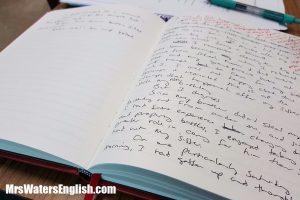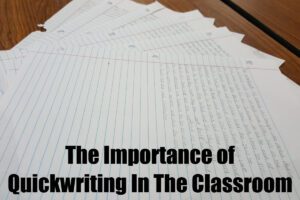In this age of high stakes multiple choice testing, writing in secondary classrooms has almost become a lost art. Thanks to programs like the Oklahoma Writing Project, which is a site of the National Writing Project established in 1978, teachers from many disciplines are learning how to bring this art back to their students.
I had the opportunity to participate in the three-week OWP Summer Institute this past summer, and I can already see that what I learned during my time there has vastly improved my teaching practice and my relationships with my students. I am more confident in my abilities and better able to verbally support the professional decisions I make because of my work with OWP. One of those decisions was to convert my daily bellwork into a quickwrite that is only sometimes graded. The purpose of the quickwrites is to enable students to practice writing on a daily basis, help students find ways to overcome writer’s block, build up students’ writing stamina, give students the opportunity to share their ideas in a safe environment, and provide students with a supply of ideas to choose from when faced with a full-length essay assignment.
Naturally, I had to get student buy-in for this project to be successful. After asking students to write a quickwrite on “The Importance of Quickwrites” (How metacognitive is that?!), I discovered one young lady who eloquently explained what quickwrites are about. Katlyn wrote:
Most students will never understand why their teachers insist on them exercising their writing skills. In my opinion, quickwrites are the perfect technique to do so. They don’t take up too much time, vary in topic, and build those instinctual reflexes in our minds.We can make connections between prompts and and our own situations that go hand in hand.
Completing quickwrites in the first five minutes of class provides many advantages. It gives students a chance to settle down. They are almost like a first time warning of good behavior directed from the teacher. While seriousness is usually the manner, sometimes you get a person who can make any situation brighter. Coming from a peer, let me just say, kids might think they are getting away with a little bit or pushing boundaries. Adding jokes or humorous memories of their own in their work, but over time their brains weave these together with the prompts given.
They don’t realize it, but their writings catch the attention of peers because their words flow together. Quickwrites are a way of exercising our techniques as maturing writers. Our minds adjust to the thought of relating topics in a snap. Quickwrites are essential to the growth and development of this generation.
If we don’t write, who will?
Who, indeed.
My overarching goal is for my students to discover that they are writers, to learn the techniques they need to tell their stories, provide information, and convince people in a written format. On top of that, I want my students to have the confidence and desire to share their writing.
Which these goals in mind, I give my students a writing prompt each day. I frequently give them narrative, expository, or argumentative prompts, but also sometimes allow them to write about anything they want (which is interesting, because some students almost demand time to write about what they want, and others are completely lost when presented with the opportunity). My goal towards the end of this semester is to give my older students the opportunity to choose their own quickwrite prompts and topics.
After the bell rings, students write for five minutes, then share with a table partner. Everyone participates, even though I don’t grade them all, which I believe is because they immediately publish their work as soon as they finish writing. We also frequently have an opportunity to share with the class. Students can volunteer themselves or “voluntold” someone else (who is allowed to decline). Students stand up, and I encourage them to read loudly enough for all to hear, and to read with confidence.

I also participate in quickwrite time. You can see my journal of quickwrites in the photograph above. Not only does this give me an opportunity to model quickwriting for my students, but also demonstrates the importance of the activity. I knew this was working the day a student stated aloud in class that he knew I understood what my students are experiencing because I was completing the assignments right beside them.
Students then store their quickwrites in the Quickwrites section of their binders. I instruct my students to fold in half any quickwrites they think they’d like to expand into a full-length essay later. Once per nine weeks, I assign an essay to students, who then select the topic they want to write about from the quickwrites they’ve marked.
These quickwrites have given me the opportunity to get to know my students better, them the ability to express their thoughts and feelings in writing, and all of us the opportunity to share and publish our work. Ultimately, my goal is to help my students realize they’re are writers and that they have the tools and power to share their stories.
Need help getting started with quickwrites in your classroom?
Download these quickwrites to start your school year off on the write foot!


Thank you for sharing the QWP. I saw a documentary on youtube, not long ago, about a teacher in Japan who did his own version of QWP with his 5th grade class every day. Besides learning to write neatly in Japanese, they were encouraged to write about their feelings. Their feelings included those about how Things were for them in class as well as at home. The teacher learned alot about his students, but was also able to use this information to encourage them to be communicative about their feelings. During the year that the documentary was made, several pupils lost either a parent or grandparent which caused them great distress. By their and their classmates writing about these situation, the bereaved pupils were given lots of support in their time of need that they might not have had otherwise. Again, thank you for sharing a task I intend to take up with my pupils.